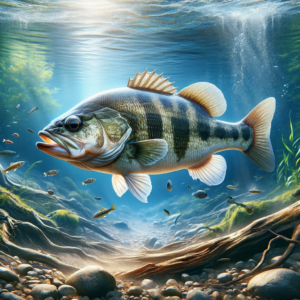Have you ever wondered how smallmouth bass survive in cold water? It’s fascinating to think about how these fish can tolerate extreme temperatures. In this article, we will delve into the topic of the preferred temperature range of smallmouth bass and explore just how cold is too cold for them. By understanding their temperature preferences, we can better understand their behavior and even improve our chances of catching them. So, let’s dive in and learn more about the fascinating world of smallmouth bass and their preferred temperatures.
Smallmouth bass are known for their adaptability to different environments, including varying water temperatures. However, there is a limit to how cold they can withstand. Typically, smallmouth bass prefer water temperatures between 60 to 75 degrees Fahrenheit. But what happens if the water gets too cold for them? Do they simply hibernate or migrate to warmer waters? These questions will be answered as we delve deeper into this topic.
To fully grasp the preferred temperature range of smallmouth bass, it’s important to understand their biology and behavior. Smallmouth bass are ectothermic, meaning that their body temperature is dependent on the surrounding environment. Thus, they are more active and thrive in warmer waters. However, they do have some mechanisms to withstand colder temperatures. In this article, we will explore these mechanisms and shed light on just how cold is too cold for these resilient fish.
So, whether you’re an angler looking to catch smallmouth bass or simply curious about their temperature preferences, this article will provide you with valuable insights. By the end, you’ll have a better understanding of the preferred temperature range of smallmouth bass and the factors that influence their survival in colder waters. Let’s get ready to dive into this fascinating topic and discover the secrets of smallmouth bass’s temperature tolerance.
Understanding the Preferred Temperature Range of Smallmouth Bass
Smallmouth bass, also known as “smallies,” are a popular freshwater game fish in North America. Anglers are often intrigued by the habits and preferences of these fish, including their preferred temperature range. Understanding the role of temperature in smallmouth bass habits is crucial for successful fishing and conservation efforts.
Role of Temperature in Smallmouth Bass Habits
Temperature plays a vital role in the behaviors and habits of smallmouth bass. Like all fish, smallmouth bass are ectothermic, meaning their body temperature is influenced by the surrounding environment. They cannot regulate their own body temperature, so they rely on the water temperature to govern their metabolism, activity levels, and feeding patterns.
Ideal Temperature Range for Smallmouth Bass
Smallmouth bass are known to thrive in a specific temperature range. The ideal temperature range for these fish generally falls between 55°F and 75°F (12°C to 24°C). Within this range, smallmouth bass are most active, displaying increased feeding and reproductive behaviors. This temperature range provides optimal conditions for their metabolism, making it easier for them to find and consume prey.
Importance of Temperature for Smallmouth Bass Survival
Temperature is crucial for the survival of smallmouth bass. Extremely cold or hot water can pose significant challenges to their health and survival. Smallmouth bass are cold-water species, so they are better adapted to survive in cooler temperatures than their warm-water counterparts. However, extreme temperatures outside their preferred range can have detrimental effects on their physiological processes and overall well-being.
Factors Affecting Smallmouth Bass Temperature Preferences
Several factors influence the temperature preferences of smallmouth bass. One key factor is the availability of adequate dissolved oxygen in the water. Cooler temperatures generally hold more dissolved oxygen, whereas warmer temperatures can lead to reduced oxygen levels. Additionally, smallmouth bass prefer areas with suitable cover, such as rocks, logs, or vegetation, which can provide shade and protection from extreme temperatures.
Another factor is the reproductive cycle of smallmouth bass. During the spawning season, which usually occurs in late spring or early summer, smallmouth bass are more tolerant of higher temperatures as they actively seek out warmer shallow waters for spawning purposes. Outside of the spawning season, they tend to prefer cooler waters.
The Impact of Cold Temperature on Smallmouth Bass
While smallmouth bass are better adapted to cooler temperatures compared to other warm-water fish, extremely cold water can still have a negative impact on them. When water temperatures drop below 50°F (10°C), smallmouth bass become less active, their metabolism slows down, and their feeding behaviors decrease. Ice formation, which occurs in very cold temperatures, can also limit their ability to access prey and may lead to starvation.
The Effects of High Temperatures on Smallmouth Bass
Smallmouth bass are more susceptible to the negative effects of high temperatures compared to low temperatures. When water temperatures exceed 80°F (27°C), smallmouth bass become stressed, and their growth rates may be negatively affected. High temperatures can also lead to diminished dissolved oxygen levels, making it harder for smallmouth bass to obtain sufficient oxygen for survival. In extreme cases, prolonged exposure to high temperatures can even be fatal for these fish.
Adaptations of Smallmouth Bass to Different Temperatures
Smallmouth bass have several adaptations that help them cope with different temperature conditions. In cooler temperatures, they may congregate in deeper waters or areas with thermal refuges, such as springs or inflowing streams, where the water temperature remains relatively stable. This allows them to conserve energy and avoid extreme temperature fluctuations.
During warmer temperatures, smallmouth bass may display behavioral adaptations. For example, they may seek out cooler areas, such as shade or deeper sections of the water, to avoid excessive heat and maintain their preferred temperature range. These adaptive behaviors help smallmouth bass survive and thrive in varying temperature conditions.
Behavioral Changes in Smallmouth Bass Due to Temperature
Smallmouth bass display distinct behavioral changes as a result of temperature fluctuations. In cooler temperatures, they may exhibit reduced activity levels, slower movement, and decreased feeding. During periods of low temperatures, smallmouth bass tend to conserve energy and become less aggressive in their pursuit of prey. However, as the water temperature rises within their preferred range, their activity levels increase, and they become more active hunters, often pursuing baitfish and other prey.
Optimal Temperature for Smallmouth Bass Fishing
Understanding the preferred temperature range of smallmouth bass can greatly enhance the success of fishing endeavors. When water temperatures are within the ideal range of 55°F to 75°F (12°C to 24°C), smallmouth bass are more likely to be active and readily respond to bait and lures. Fishing during these temperature conditions increases the chances of a successful and enjoyable angling experience.
Conclusion
Temperature plays a crucial role in the habits, growth, and survival of smallmouth bass. Understanding their preferred temperature range, the effects of extreme temperatures, and their behavioral adaptations can greatly assist anglers in targeting these fish effectively. Proper conservation measures, such as promoting suitable habitat conditions and ensuring water quality, are essential for maintaining healthy populations of smallmouth bass. By respecting and appreciating their temperature preferences, we can better enjoy the thrill of fishing for smallies while ensuring their long-term survival.




